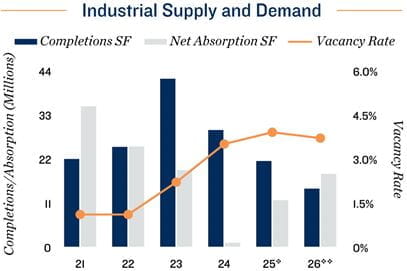Research Brief
Canada Employment
November 2025

Resilient Labour Market Could Signal Turning
Point for Commercial Real Estate
Employment strength defies expectations. Canada’s labour market posted another surprisingly strong performance in October, adding 66,600 jobs and pushing the unemployment rate down 20 basis points to 6.9 per cent. The gains were concentrated in private-sector industries tied to trade, with notable increases in wholesale and retail trade, transportation and warehousing, and manufacturing. These results suggest that despite elevated uncertainty surrounding tariffs, the domestic economy remains resilient — helped by a relatively low effective U.S. tariff rate and improving sentiment in goods-producing sectors. Although total hours worked edged lower amid labour disputes and an education-sector pullback, the broader picture points to a market regaining balance as population growth moderates and earlier hiring softness begins to reverse.
Terminal rate may have been reached. October’s strong employment results bolster the Bank of Canada’s case for holding rates steady in December. That aligns with its recent message that policy is now appropriately restrictive. The combination of solid job creation and easing population growth suggests the economy is finding a better balance, reducing the urgency for further near-term stimulus. Some forecasters, however, still anticipate additional easing in 2026, with terminal rate projections as low as 1.75 per cent. But two consecutive upside surprises in employment and expectations for firmer economic growth next year have lowered the odds of further rate cuts in the months ahead.
Commercial Real Estate Outlook
Industrial momentum signals potential market turning point. October’s hiring surge across trade-exposed sectors may mark an early sign that Canada’s industrial real estate market is stabilizing. As these segments regain footing, demand for logistics and production space could begin to firm through early 2026, setting the stage for a gradual improvement in occupancy and absorption later in the year. This outlook is further supported by a more accommodative monetary policy backdrop, which should bolster consumption and business investment, alongside greater clarity on trade policy and the winding-down of Canada’s historic industrial construction cycle. Together, these forces point to a sector transitioning from correction toward renewed balance, with vacancy likely to peak around 4.0 per cent before inching slightly lower next year.
Labour bounce back reinforces stability across asset classes. Persistent job growth despite global headwinds underscores the underlying strength of Canada’s economy, providing a firmer foundation for commercial real estate heading into 2026. Healthy employment levels support tenant retention and leasing demand across industrial, retail and select office segments. Moderating borrowing costs are expected to revitalize investment activity as confidence rebuilds. Although risks tied to tariffs and fiscal pressures remain, the combination of a
steady labour market and a more predictable rate environment should help anchor pricing expectations and foster a more balanced investment landscape during 2026.


* Through October; ** Forecast provided by Capital Economics; v Estimate; vv Forecast
Sources: Marcus & Millichap Research Services; Altus Data Solutions; Capital Economics; CoStar
Group, Inc.; Statistics Canada
TO READ THE FULL ARTICLE

